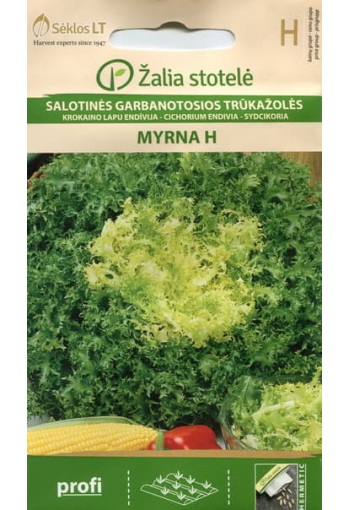Ex Tax: 0.99€
Indispensable vitamin greens for diabetics!
An annual plant from the Asteracea family. Forms a powerful root rosette of leaves and root crop. The leaves are green, wide, indented, curly, with a slightly bitter taste.
"Myrna" is an early ripe and high-yielding hybrid of radicchio for growing in open and protected ground, forming large rosettes of corrugated leaves: light in the center and dark green at the edges.
The value of the hybrid: cold resistance. It is characterized by a long consumer life, even at high temperatures, you can cut heads , which do not let flower arrows.
This variety of salad is distinguished not only by its excellent taste, but also by its decorative effect.
An excellent dietary product that contains easily digestible inulin, which is essential for diabetic patients. Increases the tone of the body, improves appetite and digestion, has a beneficial effect on the nervous system.
It is eaten fresh, stewed, fried, used for making salads.
1 gram = 800-1000 seeds.
* Now this beautiful plant is very rarely found in gardens and vegetable gardens, although it is very promising to grow it in the area of large cities.
Endive is interesting in that it supplies the table with excellent salad greens in the autumn-winter period, when the stock of ordinary green vegetables is running out. To remove the spicy bitterness, the green leaves are boiled or kept in salt water for 20 minutes, washed, drained and used for salads, side dishes, soups, stew, etc.
The most important biological feature of endive is the rapid formation of a large rosette of leaves. In a short time, a powerful outlet with a mass of 300-400 g and more develops.
Endive leaves are elongated, deeply dissected with strongly curled edges. The color of the leaves, depending on the variety, varies from yellowish green to dark green.
The root of the plant is small, woody, branched. With the onset of long days and elevated temperatures, plants quickly develop upright and branched flower shoots with inflorescences consisting of numerous small lilac flowers.
Surprisingly, this southern plant has exceptional cold resistance. At an early age, it tolerates frosts down to minus 4-6 ° C, which is very important when using it directly from the garden in late autumn. In fact, it can be harvested from the garden before the snow cover.
To have fresh salad in late autumn, sowing is carried out in the summer, and in the fall the plants are harvested by the roots in a greenhouse, which, with the onset of cold weather, is covered with frames and mats. For the winter consumption of lettuce, the plants are added to the wet sand in storage facilities. With good ventilation, they remain there for several months. In winter, endive and escariol can be grown in greenhouses using the same agricultural techniques as for head lettuce.
Leaves of young (in the rosette phase) plants are used for food, more often it is used as a salad, less often - boiled or stewed. They are also used to decorate various dishes.
Eating chicory salads improves the functioning of the digestive system and circulatory system.
Fresh, coarsely chopped leaves are eaten, seasoned with vegetable oil, vinegar or lemon juice with added sugar and salt, sprinkled with parsley. In this case, for 500 g of leaves, take 2 tablespoons of oil and 1 tablespoon of vinegar.
The endive and escariol are stewed over low heat for 30 minutes (750 g of chopped leaves and 60 g of butter, salt to taste), and poured with lemon juice before serving.
Eng.: Curly endive. Suom.: Kähäräendiivi, "frisee" sikurisalaatti. Sven.: Friseesallat (cikoriasallat). Bot.: Cichorium endivia L.











